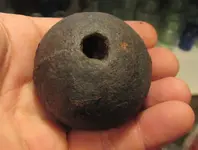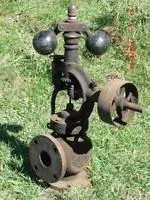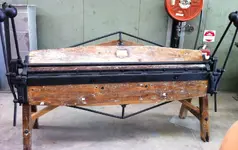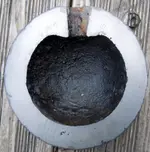What "tells the tale" about whether that ball is an explosive Artillery ball or not is very-precise weighing and diameter-measuring. If it is just a Solid ball with a casting-flaw hole (or a drilled-in hole) in it, instead off having a powder-cavity, it will weigh almost as much as an all-solid ball.
To achieve absolute certainty, you'll need to measure your ball's diameter with a Digital Caliper, which measures in hundredths-of-an-inch. Perhaps you've already done that. I can't be sure whether you did or didn't, because saying it is 2.25-inches (2-&-1/4) could be either a ruler-made estimate or a Digital Caliper measurement.
Meanwhile... the 1861 US (and CSA) Ordnance Manual's "Shot Tables" charts say a 2.25"-diameter SOLID iron ball weighs precisely 1.5 pounds (24 ounces). Your said your ball is 2.25" and weighs 1.35 pounds (21.5 ounces). That is a difference of only 2.5 ounces. Being only 10% lighter than a Solid ball of the same diameter means your ball definitely is not a hollow explosive artillery ball. The photo below shows how large the powder-cavity is in an explosive cannonball -- the powder-cavity causes the ball the be AT LEAST 30% lighter than a Solid ball of the same diameter.
However, your ball MIGHT be an Artillery ball which has a big casting-flaw. The Ordnance Manual's charts list a 42-Pounder (7"-caliber) Canister-ammo ball as being 2.22 to 2.26-inches in diameter. (That is why measuring you ball with a Digital Caliper in hundredths-of-an-inch is crucially needed.)
But you say the hole in your ball is too "regular-shaped" to be a casting-flaw. If you are correct about that, it means the hole is a drilled-in hole, and thus your ball is not an Artillery ball. (And it means BosnMate's identification of your ball is correct.)
Link to view the Ordnance Manual's "Shot Tables" artillery-balls diameter and weight charts -- check the section on Canister-ammo balls:
www.civilwarartillery.com/shottables.htm Could it be a small cannonball/shell? It's 1.35 pounds and 2.25" in diameter. I can't match it online. Anyone?
Could it be a small cannonball/shell? It's 1.35 pounds and 2.25" in diameter. I can't match it online. Anyone? Could it be a small cannonball/shell? It's 1.35 pounds and 2.25" in diameter. I can't match it online. Anyone?
Could it be a small cannonball/shell? It's 1.35 pounds and 2.25" in diameter. I can't match it online. Anyone?





